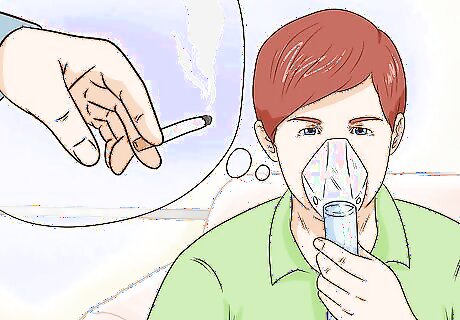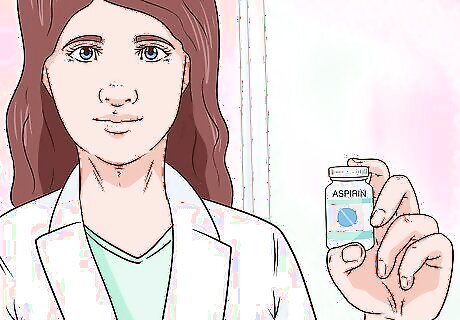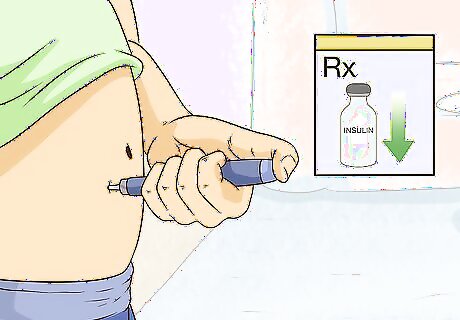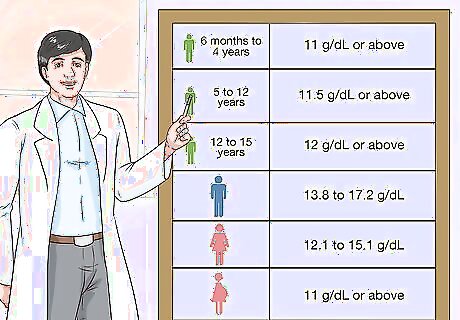
views
Seeking Medical Treatment Options

Determine the underlying cause of your high hemoglobin level. An elevated hemoglobin reading nearly always indicates an underlying medical condition, environmental factor, or lifestyle choice. If you haven’t already identified this underlying cause, work with your doctor to reach an appropriate diagnosis. In virtually all cases of high hemoglobin, the goal is to treat the underlying cause, which will in turn lower your hemoglobin level. Your hemoglobin level is a signpost that indicates a range of possible conditions that may need treatment. If it’s too low and needs to be higher, or too high and needs to be lower, your medical team will work to identify and treat the underlying cause or causes.

Treat any medical conditions causing your high hemoglobin. This will depend on whether your condition is relative, such as caused by tobacco use, or if it’s absolute polycythemia, which results in increased red blood cell (RBC) mass due to elevated serum erythropoietin or production of RBCs. Many different medical conditions can lead to elevated hemoglobin levels. Follow the advice of your medical team regarding the best treatment options for you. Common conditions that require treatment include: Dehydration Polycythemia vera, which is when your bone marrow produces too many red blood cells Heart problems, especially congenital heart disease Lung diseases, such as emphysema, COPD, and pulmonary fibrosis Kidney cancer or tumors Liver cancer or tumors Hypoxia, which is when you have low blood oxygen levels Carbon monoxide exposure, usually due to smoking

Make necessary lifestyle changes to lower your level. If it’s not a medical condition causing your elevated hemoglobin, then the culprit is likely an environmental factor or lifestyle choice. Work with your doctor to determine if lifestyle changes are recommended. Common examples include: Using tobacco products. If you smoke or use other tobacco products, work to quit as soon as possible. Taking performance-enhancing drugs like steroids, and especially using “blood doping” for athletic performance enhancement. This is detrimental to your health for many reasons. Spending time at high altitudes, which can cause hypoxia (low oxygen levels in the blood). This is more likely to be a problem for people who travel into high altitudes (such as mountain climbers) rather than people who live there.

Discuss phlebotomy treatments with your doctor as needed. In limited cases, your doctor may want to reduce your hemoglobin levels more directly. If so, you’ll likely undergo one or several phlebotomy treatments, during which a set amount of blood will be drained from your body. If the underlying cause of your high hemoglobin is also being addressed, you should be producing new blood with normal hemoglobin levels. So, over time, your overall hemoglobin levels will reduce to normal. The process is similar to donating blood.

Ask your doctor about prescription medications for polycythemia. If you have polycythemia and that is causing your high hemoglobin levels, work with your doctor to treat the condition. Your doctor may recommend a prescription medication as part of your treatment. Commonly used medicines for polycythemia include: Hydroxyurea Ruxolitininab Pegelated interferon Anagrelide

Talk to your doctor about taking aspirin daily. Aspirin can help to thin your blood, which may be useful if you have polycythemia. Talk to your doctor about taking aspirin daily if you have this condition. Find out what dose you should take and how often to take it. Don’t begin aspirin therapy without your doctor knowing about it first.Tip: Make sure to tell your doctor about any prescription or over-the-counter medications you are taking.
Lowering Your HbA1c Level

Eat a healthy diet based on your particular needs. If you have an elevated HbA1c level, you’re likely at risk for developing diabetes or already have the condition. Therefore, your dietary needs may be somewhat different from the standard advice, based on your particular circumstances. Work with your medical team to develop the proper diet for you. In general, a healthy diet involves eating more fruits and vegetables, whole grains, lean proteins, and healthy fats, and eating fewer packaged and processed foods, sugary drinks, refined grains, and unhealthy fats. If you have pre-diabetes or diabetes, you may be advised to limit your carbohydrate intake and adjust your protein and fat intake, based on your unique needs.

Get regular exercise as advised by your doctor. If you have elevated HbA1c due to pre-diabetes or diabetes, you should work with your medical team to create an exercise plan that suits your current health and needs. In any case, it’s important to engage in both cardiovascular and strength training exercise to see the greatest benefits. Aim for at least 150 minutes of moderate-intensity aerobic exercise (such as brisk walking or biking) per week, and do 2-3 strength training sessions per week that last about 30-45 minutes each. If you are on insulin, you may need to adjust your dosage based on your exercise schedule. Work with your doctor to fine-tune your plan.

Adjust your diabetes medications if you have diagnosed diabetes. Anyone with an elevated HbA1c level will be advised to make dietary and exercise changes. If you have diagnosed diabetes, your doctor will also likely advise making adjustments to your current medication regimen. The goal is to find the proper medication balance that best manages your blood glucose levels (and therefore your HbA1c readings).Tip: Never feel like you’re “failing” at managing your diabetes if you have to change medications or increase your dosage. Diabetes management always requires ongoing adjustments

Focus on achieving a slow, steady decrease in HbA1c. By making immediate and extreme dietary and exercise changes, it may be possible to rapidly decrease your HbA1c level in 1-2 months. However, dropping your HbA1c too quickly can lead to swelling, weight gain, neuropathy (nerve pain), and possibly even bleeding in the retinas that can cause blindness. Follow your medical team’s guidance and, unless otherwise directed, make gradual adjustments to your diet, exercise program, and medication regimen. Your goal will likely be to reduce your HbA1c level over the course of 1-2 years rather than 1-2 months.
Testing Hemoglobin and HbA1c Levels

Have your hemoglobin checked as part of standard blood testing. High hemoglobin carries no symptoms on its own, so it’s usually discovered in one of two ways: during standard, occasional blood testing requested by your doctor; or, during blood testing done as part of the diagnosis for an underlying medical condition. High hemoglobin will be detected during a CBC (complete blood count) test, which is the standard blood draw done at medical facilities.Tip: Get CBC testing done whenever your doctor recommends it. CBC testing can aid in early detection of infections, cancers, bone marrow disorders, and autoimmune conditions, among others.

Discuss your ideal hemoglobin range with your doctor. The ideal hemoglobin range isn’t the same for everyone, as it varies based on factors such as age. For example, here is one widely-used hemoglobin range chart: Children ages 6 months to 4 years: 11 g/dL or above Children ages 5 to 12 years: 11.5 g/dL or above Children ages 12 to 15 years: 12 g/dL or above Males over age 15: 13.8 to 17.2 g/dL Females over age 15: 12.1 to 15.1 g/dL Pregnant females: 11 g/dL or above

Get your HbA1c checked every 3 months if you have diabetes. Due to hemoglobin’s life cycle, your HbA1c reading provides a snapshot of your average blood glucose level over the past 3 months. Therefore, it’s essential for people with diabetes to have their HbA1c tested via blood draw every 3 months. Your doctor will fine-tune your treatment program based on your most recent HbA1c results. If you have pre-diabetes, which means you nearly meet the criteria for a diabetes diagnosis, your doctor might also recommend testing every 3 months. If you don’t have diabetes or pre-diabetes and aren’t at elevated risk, you’ll probably only have your HbA1c tested occasionally as part of general blood testing.

Work with your doctor to determine your particular HbA1c goal. Your HbA1c level is one of the determining factors in diagnosing pre-diabetes or diabetes. If you’ve already been diagnosed, your medical team will determine the appropriate HbA1c goal for you. An HbA1c reading below 5.7% is considered normal for someone without pre-diabetes or diabetes. If you have an HbA1c level between 5.7% and 6.4%, you may be diagnosed with pre-diabetes. An HbA1c result that’s over 6.5% may result in a diabetes diagnosis. If you have diabetes, your goal will likely be to keep your HbA1c level under 7%. This depends on your particular circumstances, however.



















Comments
0 comment